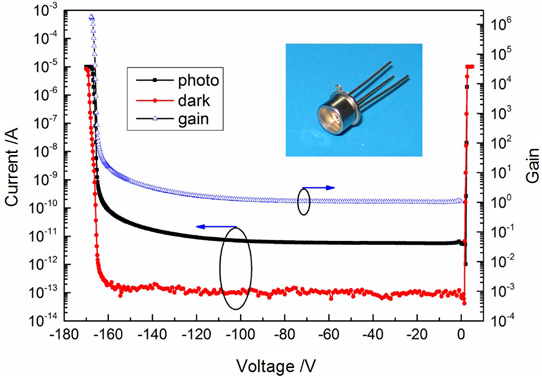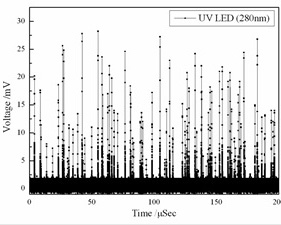- News
11 January 2016
GaNo Opto launches first commercial SiC UV APD
GaNo Optoelecteronics Inc of Yangtze River Delta Economy Park, Jiangsu Province, China – which offers UV sensors and modules based on wide-bandgap semiconductors including nitide (GaN) and silicon carbide (SiC) – has released what it claims are the first commercial SiC-based ultraviolet avalanche photodiodes (APDs). The intrinsically visible-blind APD can work in either linear or Geiger mode with UV photon counting capability.
SiC UV APDs have attracted much attention from both academics and industry because of their potential applications in corona discharge and flame detection, UV fluorescence, UV astronomy, UV ladar (lidar) and communication, as well as the detection of jet engines and missile plumes, says GaNo Optoelecteronics.
Traditionally, bulky photomultiplier tubes (PMTs) must be used in these applications, where the UV signals to be detected could be very weak. SiC APDs are a promising alternative to replace PMTs, when ruggedness, compactness, low cost, long lifetime and low voltage operation are needed. However, the implementation of SiC UV APDs is very challenging due to substrate or epi-related material defects, relatively poorly modeled device operation, and immature device processing technology.
Most recently, GaNo Opto has started volume production of high-performance SiC APDs with what is said to be high gain up to 106 and the capability of single-photon counting combined with a low dark-count rate of ~1Hz/mm2 at room temperature. Under particular conditions, the device could even conduct single-UV-photon counting at high temperatures up to 150oC, it is reckoned.

Fig. 1 Room-temperature photo and dark current characteristics of the SiC APD.
"It has been well accepted that wide-bandgap semiconductor is the most suitable material for making UV photodetectors," says GaNo Opto's chief technology officer Dr Hai Lu, who is also distinguished professor at Nanjing University. "Although commercially available silicon APDs demonstrate moderate quantum efficiency in the UV wavelength range, they require highly expensive optical filters to achieve a high UV/visible rejection ratio as their peak response stays within the visible wavelength range. In addition, Si APDs with very low dark counts were only demonstrated when they were cooled to liquid nitrogen temperatures," he notes.
 Fig. 2 Real-time photon counting spectrum of the SiC APD.
Fig. 2 Real-time photon counting spectrum of the SiC APD.
"Our process shows that appropriate termination and surface passivation techniques are critical for realizing SiC APDs with low leakage current and resulting high avalanche gain, both of which are necessary for the device to operate in single-photon-counting mode," Lu continues. "Leakage current as low as in sub-pA level is achieved at 98% breakdown voltage," he adds.
"Our next step is to develop UV imaging arrays based on SiC APDs. In this case, uniformity among each APD pixels and scalability would be the main technological barriers," Hai reckons. "New implantation and dopant activation sequences, and backend processing techniques are being developed to achieve this goal."


